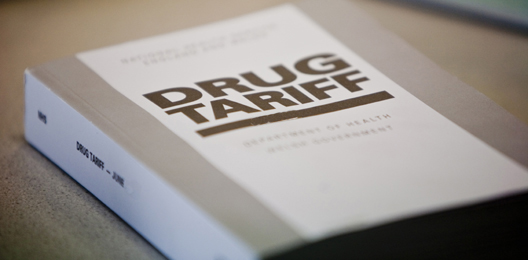Prescriber cost centre codes
Published on: 17th July 2013 | Updated on: 30th March 2022
On 1st April 2013, a new requirement was brought in to ensure prescriptions contain a prescriber cost centre code. During pricing, the Pricing Authority use this code to identify the cost centre in order to recharge the costs to the appropriate area and to provide data on prescribing information.
The cost centre codes can be found on the top right-hand corner of the prescriber details box at the bottom of the prescription form.
Part II clause 6 of the Drug Tariff provides the following information relating to the identification of the prescriber.
‘Where a contractor provides the drugs or appliances ordered on any NHS prescription form, except forms issued by a Dental Practitioner, the Pricing Authority may return the prescription form to the contractor (as a referred back) if there is no prescriber code(s) present on the prescription form and request that the contractor seek the appropriate code(s).
Where the contractor is able to identify the appropriate code(s), they shall endorse the prescription with the code and return it to the Pricing Authority. Where the contractor is unable to identify the appropriate code(s), they shall endorse the prescription to indicate that they have been unable to locate the code and return it to the Pricing Authority to be paid. Returned prescriptions shall be priced using the Drug Tariff relevant to the month in which the prescription is returned to the Pricing Authority.’
Prescriber
These forms will only require one code— which links the prescriber to the practice where they work (see below).

Non-medical prescriber
Non-medical prescribers will need two codes — one identifying them as a prescriber and one that identifies the practice where they work. The only exception is where they use a hospital unit code (see below).

Hospital
Medical and non-medical hospital prescribers who issue FP10 prescriptions in a hospital setting have one cost centre code— this code links the prescriber to the hospital unit where they work. The hospital unit code enables the correct Trust to be invoiced and to determine the prescribing for individual units. Some hospital prescribers may also work for a cost centre; the codes are the same codes as for a GP practice.

Dentist
Dental prescriptions do not require a prescriber cost centre code and should be processed as normal.
Pharmacy team requirements
It is really important that pharmacy teams check prescriptions for prescriber cost centre codes at the time of dispensing and attempt to identify and insert codes where any are missing.
Pharmacy staff are not expected to validate prescriber codes, they are only expected to ensure that the code is present. The Pricing Authority validates these codes; prescriptions with incorrect codes will still be paid and will not be returned to the pharmacy.
Prescriptions missing the prescriber cost centre code (except dental prescriptions) may be returned to the contractor by the Pricing Authority as a referred back form. This could lead to a delay in payment for that prescription.
If your pharmacy team receive a referred back form which is missing a prescriber code, and are able to identify the code, the code should be added to the form and returned to the Pricing Authority in the next month’s submission.
If the pharmacy team has been unsuccessful in identifying the code, the prescription should be endorsed to that effect and then returned
In either case, when resubmitted, the prescription will be paid according to the rules for the month in which it is re-submitted. The contractor will not be paid until the prescription has been returned to the Pricing Authority.
FAQs
No. Pharmacy contractors are only expected to ensure that a code is present. Sometimes, in the case of hospital prescriptions, the code may be related to a hospital unit rather than an individual prescriber. Pricing Authority staff will check during the recharging process that the code is correct. As the contractor is not expected to perform any extra work by attempting to validate codes, prescriptions will not be returned to the pharmacy if a code is later identified as being incorrect. These prescriptions will still be paid as normal within the usual time-frames. However, if a contractor suspects the prescription is not a genuine order for the person named on the prescription (e.g. they believe it has been stolen or forged), they should continue to refuse to dispense for that reason. No. Pharmacy staff are not expected to validate prescriber codes, they are only expected to ensure that the code is present. The Pricing Authority validates these codes; prescriptions with incorrect codes will still be paid and will not be returned to the pharmacy. Pharmacy teams wishing to validate a prescriber code can search professional registers such as the Health & Care Professions Council (HCPC). You can search the HCPC register using either the prescribers surname or registration number. Important information relating to Non-Medical Prescriber codes in EPS Please note that EPS has a set format for non-medical prescriber codes (Podiatrist, Physiotherapist, Radiographer, Dietician and Paramedic prescribers) to contain 8 characters, however, some professional codes for non-medical prescribers may only be 7 characters longs. Where a non-medical prescriber has a code that is 7 characters long systems are set up to pad out the code with an additional ‘0’ to ensure the code is 8 characters long. This can mean that where a code is padded out and you search on the register it will not return a result. Where a pharmacy team enters a code that returns no result in the search it is advised that you remove the leading ‘0’ from the code and renter the code. Example: In the example above pharmacy teams would need to remove the additional ‘0’ (highlighted in red for emphasis) before rechecking the HCPC register. Community Pharmacy England has pressed for the registers and systems to use a common standard (eight digits) and to reduce associated and unneeded pharmacy burden.
True 7 character code
Padded 8 character code version
PA04606
PA004606
No. Pricing Authority has confirmed that dental prescriptions do not have prescriber codes and therefore pharmacy contractors can dispense and submit these prescriptions without needing to identify or endorse a prescriber code.
Prescriptions will be reimbursement according to the Drug Tariff price for the month the prescription is resubmitted.
Related Resources












